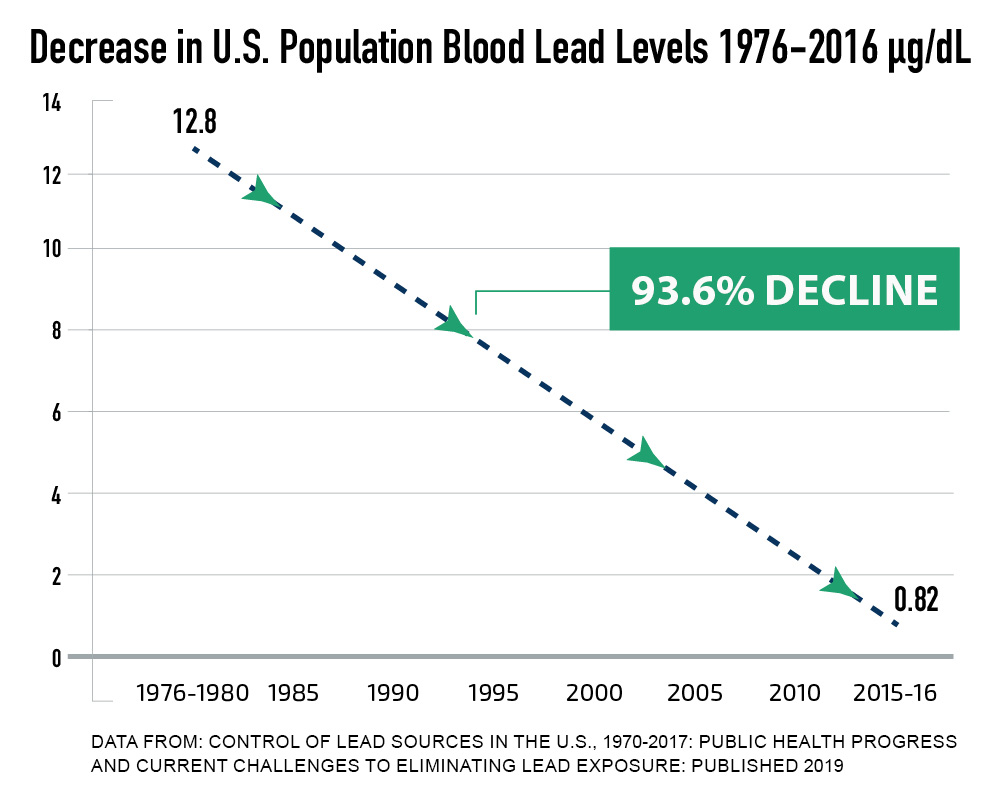There are many sources of lead in the environment, including lead from historic leaded gasoline and lead paint, electricity generation, mining, manufacturing, and recycling of lead. There is also lead in various industrial processes and consumer products such as car batteries in hundreds of millions of vehicles nationally, lead in jewelry and toys, lead in ammunition and fishing gear, and many others, not to mention naturally occurring lead in soil and water.
About 10 billion pounds of lead is mined annually for use in a wide array of applications. The presence of lead in soil, sediment, or water is not sufficient to conclude that the source of lead is telecom cables. According to the Department of Health and Human Services’ Agency for Toxic Substances and Disease Registry (ATSDR), most human exposure to lead occurs through inhalation and ingestion.
Learn more about how lead is regulated, where it exists in the environment, and its most likely sources for exposure:

Drinking Water
The EPA regulates public water suppliers that provide drinking water to households as well as commercial operations around the country. Those suppliers are required to meet regulatory standards for various substances, including lead. The EPA and local municipal water authorities are responsible for monitoring water quality for lead.
We have not identified any scientific literature or government reports indicating that any public water supplier is exceeding the EPA standard for lead due to lead-sheathed telecom cables.
In contrast, a 2023 assessment by the EPA tracking lead in drinking water and the sources that supply public water to cities and towns found that over 9.2 million lead water service lines are still currently in use across the country. Recent testing by federal and state authorities, as well as industry partners, has shown that underwater and aerial lead cables do not pose an immediate threat to public health.
Air
The EPA establishes National Ambient Air Quality Standards (NAAQS), including for lead, that are designed to protect public health. Industrial sources are then regulated through a combination of permits and regulations. We have not identified any scientific literature or government reports indicating that NAAQS are exceeded for lead due to the presence of lead-sheathed telecom cables.
Lead in gasoline and other fuels is also regulated by the EPA, and while most leaded gasoline was phased out over 30 years ago, leaded fuel is still in use by certain aircraft. Industrial plants can have tiny particles of lead in their air emissions. Smoke from fires and cigarettes and e-cigarettes generally contains some lead too. Smokers, as well as those exposed to second-hand or third-hand smoke (i.e., the residue from smoking), may exhibit increased blood lead levels compared to those not exposed to tobacco smoke.
According to the EPA, about 70% of all lead in the air comes from piston-engine aircraft emissions. Other sources are industrial plants, such as lead smelters or waste incinerators. Recent testing by federal and state authorities, as well as industry partners, has shown that underwater and aerial lead cables do not pose an immediate threat to public health.
Soil
Lead is naturally present in soil. Background lead concentrations can vary widely from place to place and can generally range from 10 parts per million (ppm) to 200 ppm. Major sources of lead in soil in populated areas is the weathering, chipping, scraping, sanding, and sand-blasting of structures bearing lead-based paint. The EPA understood in the 1990s that airborne emissions from smelters, waste incinerators, and a wide range of other industries, as well as fuels, paints and pigments, aircraft, and automobiles, contributed to the widespread presence of lead in soil.
Food
There are some trace amounts of lead in food and beverages, including vegetables, fruits, and grains where lead in the air can settle on foods or be taken up from the soil. The Department of Health and Human Services’ Agency for Toxic Substances and Disease Registry (ATSDR) estimates that Americans consume between 2 and 9 mcg/kg of lead per day with children under two years old consuming less than 4 mcg/kg of lead per day. We have not identified any scientific literature or government reports indicating that any food in the U.S. is exceeding a standard for lead due to lead-sheathed telecom cables.
